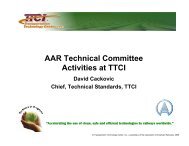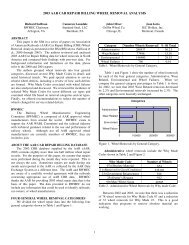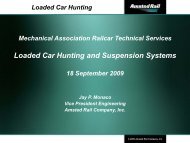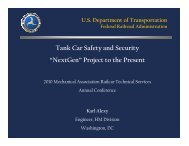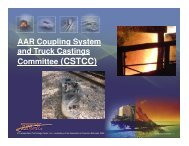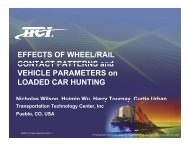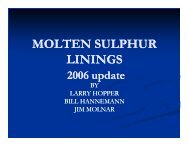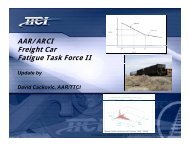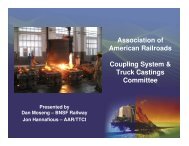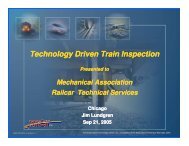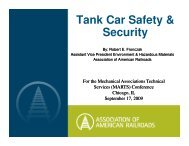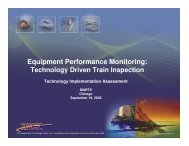Findings of the Wheel Defect Prevention Research ... - Marts-rail.org
Findings of the Wheel Defect Prevention Research ... - Marts-rail.org
Findings of the Wheel Defect Prevention Research ... - Marts-rail.org
Create successful ePaper yourself
Turn your PDF publications into a flip-book with our unique Google optimized e-Paper software.
<strong>Findings</strong> <strong>of</strong> <strong>the</strong> <strong>Wheel</strong> <strong>Defect</strong><br />
<strong>Prevention</strong> <strong>Research</strong> Consortium<br />
Scott Cummings<br />
MARTS Technical Conference<br />
September 22, 2008<br />
Chicago, IL<br />
WDPRC - 1 © Transportation Technology Center, Inc., a subsidiary <strong>of</strong> <strong>the</strong> Association <strong>of</strong> American Railroads, 2008
Presentation<br />
� The basics<br />
� Who – are we?<br />
� What – is <strong>the</strong> goal?<br />
� Why – are we motivated?<br />
� How – do we approach <strong>the</strong> problem?<br />
� <strong>Findings</strong><br />
� Shelling vs. Spalling – Inspections <strong>of</strong> wheelsets<br />
� Spalling<br />
� Shelling<br />
� Rolling Contact Fatigue<br />
� Thermal Mechanical Shelling<br />
� Recommendations<br />
� Ongoing work<br />
WDPRC - 2 © TTCI/AAR, 2008
Who?<br />
� WDPRC = <strong>Wheel</strong> <strong>Defect</strong> <strong>Prevention</strong> <strong>Research</strong> Consortium<br />
� Government, Railroads, Private Car Owners, Suppliers<br />
� American Electric Power<br />
� Progress Rail<br />
� Amsted Rail (Griffin <strong>Wheel</strong>)<br />
� BNSF<br />
� CIT<br />
� Canadian Pacific Railway<br />
� CSX Transportation<br />
� Federal Railroad Administration<br />
� GATX<br />
� GE Rail<br />
� Holland Company<br />
� Norfolk Sou<strong>the</strong>rn<br />
� New York Air Brake<br />
� Standard Car Truck Co.<br />
(Anchor Brake Shoe,<br />
Zeftek)<br />
� Standard Steel<br />
� Sumitomo<br />
� TTCI<br />
� TTX<br />
� Union Tank Car<br />
� Union Pacific Railroad<br />
� Wabtec (Cardwell<br />
Westinghouse, Railroad<br />
Friction Products Corp.)<br />
WDPRC - 3 © TTCI/AAR, 2008
What?<br />
� Find root causes <strong>of</strong> wheel tread damage and identify remedies<br />
� Two major categories <strong>of</strong> wheel tread damage:<br />
� Slid flats and spalling:<br />
wheel sliding on <strong>rail</strong> creates<br />
enough heat to produce a<br />
metallurgical transformation<br />
and eventually produce a<br />
spall<br />
� Fatigue and shelling:<br />
repeated cycling <strong>of</strong> stresses<br />
causes cracks to form and<br />
eventually produce a shell<br />
WDPRC - 4 © TTCI/AAR, 2008
Why?<br />
� Tread damage Impact loads Damage to track and car<br />
� Almost half <strong>of</strong> <strong>the</strong> 700,000 wheelsets changed out in 2006 were<br />
due to tread damage related causes (WMC 61, 65, 67, 75, and 78)<br />
� Approximate cost in 2006: $350 million<br />
WDPRC - 5 © TTCI/AAR, 2008
How?<br />
� WDPRC utilizes diverse data sources to determine root cause<br />
� Existing literature<br />
� Inspections<br />
� Damaged and undamaged wheelsets<br />
� Good and bad actor cars<br />
� Controlled condition testing<br />
� Air brake valves<br />
� Brake shoe force<br />
� Drag brake <strong>the</strong>rmal testing<br />
� Analysis <strong>of</strong> data from wayside detectors<br />
� WILD (wheel impact load detector)<br />
� <strong>Wheel</strong> temperature<br />
� Computer simulation<br />
� <strong>Wheel</strong> sliding<br />
� <strong>Wheel</strong> fatigue<br />
WDPRC - 6 © TTCI/AAR, 2008
<strong>Findings</strong>: Shelling Vs Spalling<br />
� 163 wheelsets inspected at three shops (WMC 11,61,64,65)<br />
� Etchant applied, radial runout recorded, expert observation<br />
� Type <strong>of</strong> damage tied to car type and service<br />
� Coal cars = shelling<br />
� Noncoal cars = mix <strong>of</strong> spalling and shelling (primarily spalling)<br />
� Intermodal = <strong>the</strong>rmal mechanical shelling according to car owner<br />
WDPRC - 7 © TTCI/AAR, 2008
<strong>Findings</strong>: Shelling Vs. Spalling<br />
� Based on CRB data, overall wheel tread damage problem is split<br />
about evenly between shells and spalls<br />
� Noncondemnable defects found on many wheels removed for<br />
wear causes: tread damage more prevalent than repair records<br />
indicate<br />
WDPRC - 8 © TTCI/AAR, 2008
<strong>Findings</strong>: Spalling<br />
� Literature Review<br />
� <strong>Wheel</strong> slide tests show that <strong>the</strong> potential exists to create<br />
martensite on sliding wheels with almost any realistic combination<br />
<strong>of</strong> axle load, wheel slide duration, train speed, and wheel/<strong>rail</strong><br />
adhesion level 1<br />
� Maximum wheel slide contact patch temperatures are probably<br />
achieved within <strong>the</strong> first second <strong>of</strong> a constant velocity wheel slide 2<br />
� Multiple authors note presence <strong>of</strong> spalling on one wheel with none<br />
on <strong>the</strong> mate<br />
� Different adhesion levels on each <strong>rail</strong>, such that one wheel<br />
reaches austenitizing temperature while <strong>the</strong> o<strong>the</strong>r does not 2<br />
� Very short duration slide where one wheel stays in<br />
synchronous contact with <strong>the</strong> <strong>rail</strong> 3<br />
� Different wear rates between wheels on same wheelset 4<br />
1) Jergeus, J., Odenmarck, C., Lunden, R., Sotkovski, P., Karlsson, B., and Gullers, P., "The Silinge <strong>Wheel</strong> Flat Experiments,"<br />
Report F202, Department <strong>of</strong> Solid Mechanics, Chalmers University <strong>of</strong> Technology, Go<strong>the</strong>nburg, Sweden, 1997.<br />
2) Sawley, K.J., and J.A. Rosser, “Tread Damage in Disc-Braked <strong>Wheel</strong>s”, 9th International <strong>Wheel</strong>set Congress, Montreal, Canada,<br />
Sept 1988.<br />
3) Bartley, G.W., “A Practical View <strong>of</strong> <strong>Wheel</strong> Tread Shelling”, 9th International <strong>Wheel</strong>set Congress, Montreal, Canada, Sept 1988.<br />
4) Magel, E., and J. Kalousek, “Martensite and Contact Fatigue Initiated <strong>Wheel</strong> <strong>Defect</strong>s”, 12th International <strong>Wheel</strong>set Congress,<br />
Qingdao, China, Sept 1998.<br />
WDPRC - 9 © TTCI/AAR, 2008
More <strong>Findings</strong>: Spalling<br />
� NUCARS ®1 simulations<br />
� Traversing rough track designed to excite suspension bounce<br />
resonance<br />
� Brake retarding forces applied and wheelset rotational speeds<br />
calculated, contact patch temperatures estimated<br />
� Traversing rough track with brakes applied is probably not a major<br />
source <strong>of</strong> spalling for loaded cars<br />
� Empty cars (and especially<br />
those with malfunctioning<br />
E/L device) can slide wheels<br />
under heavy braking in low<br />
wheel/<strong>rail</strong> friction conditions<br />
regardless <strong>of</strong> track geometry.<br />
This may be a minor source<br />
<strong>of</strong> spalling<br />
1 NUCARS is a registered trademark <strong>of</strong> TTCI<br />
WDPRC - 10 © TTCI/AAR, 2008
More <strong>Findings</strong>: Spalling<br />
� Movement <strong>of</strong> cars with handbrakes applied is a major source <strong>of</strong><br />
wheel spalling<br />
� Numerous analyses have been conducted in <strong>the</strong> past that show<br />
cars with truck mounted brakes have more tread damage to <strong>the</strong><br />
wheels on <strong>the</strong> “B” end<br />
� WDPRC found 95% / 5% split in this case for a group <strong>of</strong> 294<br />
tank cars<br />
� In 2007, WDPRC updated a training video about <strong>the</strong> importance<br />
<strong>of</strong> releasing handbrakes<br />
� “Please Release Me…Let Me Roll”<br />
� Target audience is operating personnel<br />
� Free, downloadable version at www.aar.com/wdprc<br />
� Free DVD versions available to training <strong>org</strong>anizations by<br />
emailing this presenter with a request and your mailing address<br />
� Scott_Cummings@ttci.aar.com<br />
WDPRC - 11 © TTCI/AAR, 2008
Background: Shelling - RCF & TMS<br />
� RCF = Rolling Contact Fatigue<br />
� Many cycles <strong>of</strong> high stress<br />
(tangential forces)<br />
� Shakedown predicts RCF by<br />
relating<br />
� Ratio <strong>of</strong> tangential force to<br />
normal force (T/N)<br />
� Ratio <strong>of</strong> contact stress to<br />
shear yield strength (Po/K)<br />
� TMS = Thermal Mechanical Shelling<br />
� Subset <strong>of</strong> shelling – requires hot<br />
wheels<br />
� Resistance to fatigue is reduced at<br />
high temperatures<br />
� Steel properties degrade<br />
� Loaded car Po/K ~ 3, <strong>the</strong>refore<br />
RCF @ T/N ~ 0.375<br />
� T/N limited by wheel/<strong>rail</strong> COF<br />
� Typical COF values 0.35 to 0.55<br />
� Beneficial compressive residual hoop stresses are relieved<br />
WDPRC - 12 © TTCI/AAR, 2008
� <strong>Wheel</strong>/<strong>rail</strong> tangential forces are important to <strong>the</strong> stress near <strong>the</strong><br />
tread surface where cracks initiate and propagate<br />
� Tangential forces move <strong>the</strong> stress closer to <strong>the</strong> tread surface<br />
No Tangential Force<br />
Maximum Octahedral Shear Stress<br />
100<br />
90<br />
80<br />
70<br />
60<br />
50<br />
40<br />
30<br />
at <strong>Wheel</strong> Surface (ksi) Background: Shelling - RCF<br />
20<br />
10<br />
0<br />
0 0.1 0.2 0.3 0.4 0.5<br />
Tangential Force = 0.4 * Normal Force<br />
Tangential Force / Vertical Force<br />
WDPRC - 13 © TTCI/AAR, 2008
<strong>Findings</strong>: Shelling (RCF)<br />
� Most RCF damage occurs on <strong>the</strong> low <strong>rail</strong> wheel <strong>of</strong> <strong>the</strong> wheelset<br />
in <strong>the</strong> lead position <strong>of</strong> <strong>the</strong> truck during curve negotiation <strong>of</strong> a<br />
loaded car. Finding supported by:<br />
� <strong>Wheel</strong>set inspections<br />
� Revenue service<br />
Instrumented<br />
<strong>Wheel</strong>set data<br />
� NUCARS modeling<br />
� WILD data analysis<br />
Average Radial Runout (inch)<br />
0.07<br />
0.06<br />
0.05<br />
0.04<br />
0.03<br />
0.02<br />
0.01<br />
0.00<br />
Largest average runout is<br />
outboard <strong>of</strong> <strong>the</strong> tapeline<br />
Tapeline = 2.656 inches<br />
from Rim Edge<br />
0 1 2 3 4 5 6<br />
Lateral Tread Location (Inches from Rim Edge)<br />
<strong>Defect</strong> Coal <strong>Wheel</strong><br />
Avg Runout<br />
Crack Band<br />
Histogram<br />
WDPRC - 14 © TTCI/AAR, 2008<br />
35%<br />
30%<br />
25%<br />
20%<br />
15%<br />
10%<br />
5%<br />
0%<br />
Percent <strong>of</strong> Crack Bands
Shelling Progression Photos<br />
� Photos show wheel shells developing as follows:<br />
1. Crack band appears outboard <strong>of</strong> tapeline<br />
2. Cracks join to form shells<br />
Month 1 Month 5<br />
+13,000 miles<br />
Month 9<br />
+29,000 miles<br />
3. Shells grow inboard toward tapeline<br />
where contact with <strong>rail</strong> occurs on<br />
more regular basis<br />
Month 13<br />
+55,000 miles<br />
Month 16<br />
+76,000 miles<br />
WDPRC - 15 © TTCI/AAR, 2008
More <strong>Findings</strong>: Shelling (RCF)<br />
� Potential to reduce RCF with minor<br />
changes to track & operating<br />
conditions<br />
� Data analyzed from instrumented<br />
wheelsets installed in a loaded coal<br />
car: 1,500 miles in revenue service<br />
� Total distance traveled with<br />
predicted RCF damage: < 1 mile<br />
� Most curves <strong>of</strong> 4 degrees or tighter<br />
caused some predicted RCF<br />
� 4 specific locations accounted for<br />
half <strong>of</strong> predicted RCF damage<br />
� Train typically operated below<br />
curve balance speed when RCF<br />
was predicted<br />
Lead <strong>Wheel</strong>set<br />
More RCF Damage<br />
T<strong>rail</strong> <strong>Wheel</strong>set<br />
Less RCF Damage<br />
WDPRC - 16 © TTCI/AAR, 2008
More <strong>Findings</strong>: Shelling (RCF)<br />
� Potential to reduce RCF with improved trucks<br />
� NUCARS modeling <strong>of</strong> many condition combinations shows truck<br />
type to be important factor (red = RCF, blue = no RCF)<br />
M-976 Truck Standard Truck<br />
WDPRC - 17 © TTCI/AAR, 2008
<strong>Findings</strong>: Shelling (TMS)<br />
� Maximum acceptable operating tread temperature to avoid TMS is<br />
approximately 600ºF<br />
� Applying Larson-Miller equation to existing data allows time /<br />
temperature / % stress relief relationship<br />
� Sines fatigue calculation shows that wheels are far more prone to<br />
shelling in <strong>the</strong> absence <strong>of</strong> compressive residual stress<br />
� Short duration exposure<br />
allows higher temperatures<br />
� <strong>Wheel</strong>s with properly<br />
functioning brake systems<br />
do not typically reach 600ºF<br />
� Ex: 50 Hp for 30 minutes<br />
would produce 600ºF1 1) Stone, D.H., D.G. Blaine, and G.F. Carpenter. 1994. “Effect <strong>of</strong> High<br />
Horsepower Grade Braking on AAR High Friction Composition Shoes.”<br />
Proceedings <strong>of</strong> 86th Annual Convention and Technical Conference <strong>of</strong> <strong>the</strong> Air<br />
Brake Association. Chicago, IL. pp. 113-135.<br />
WDPRC - 18 © TTCI/AAR, 2008
More <strong>Findings</strong>: Shelling (TMS)<br />
� <strong>Wheel</strong> temperature variations lead to hot wheels<br />
� Data from a single wheel temperature detector<br />
installed near bottom <strong>of</strong> hill – 1,575 trains<br />
analyzed, over 600,000 wheelsets<br />
� Temperature variations found between trains<br />
� 15 trains accounted for more than 20% <strong>of</strong><br />
<strong>the</strong> descending cars with hot wheels<br />
— Train handling can affect wheel<br />
temperature shelling<br />
Sou<strong>the</strong>rn Technologies Corporation.<br />
July 2004. “SmartScanIS User’s<br />
Guide for Union Pacific,” EUD-<br />
2004194-PV, pp 137.<br />
WDPRC - 19 © TTCI/AAR, 2008
More <strong>Findings</strong>: Shelling (TMS)<br />
� <strong>Wheel</strong> temperature variations lead to hot wheels<br />
� Data from a single wheel temperature detector<br />
installed near bottom <strong>of</strong> hill – 1,575 trains<br />
analyzed, over 600,000 wheelsets<br />
� Temperature variations found within cars and<br />
between cars<br />
� 76% <strong>of</strong> <strong>the</strong> descending cars with a wheel<br />
temperature greater than 500°F had only a<br />
single wheel above this level<br />
� While <strong>the</strong> wheels in <strong>the</strong>se cars are<br />
generally at higher temperatures than <strong>the</strong><br />
wheels <strong>of</strong> o<strong>the</strong>r cars in <strong>the</strong> train, <strong>the</strong>re were<br />
large temperature differences between<br />
individual wheel locations<br />
� Repeated hot wheel behavior was found on<br />
� 37% <strong>of</strong> <strong>the</strong> descending cars with hot wheels<br />
� 20% <strong>of</strong> individual hot wheel locations<br />
WDPRC - 20 © TTCI/AAR, 2008
More <strong>Findings</strong>: Shelling (TMS)<br />
� The cause <strong>of</strong> hot wheel behavior within cars and between cars is<br />
difficult to identify<br />
� Inspection shortly after passing temperature detector<br />
� 1 car found with handbrake applied, all wheels hot<br />
� No cause found for 14 o<strong>the</strong>r cars inspected<br />
� Detailed inspection/teardown/brake test<br />
� Good and bad actor cars selected based on multiple wheel<br />
temperature readings<br />
� Found one bad actor car with valve leaking air into brake<br />
cylinder<br />
� The selection <strong>of</strong> bad and<br />
good actor cars based on<br />
wheel temperatures<br />
correlated well with wheelset<br />
replacements<br />
— Bad actors had twice as<br />
many replacements<br />
WDPRC - 21 © TTCI/AAR, 2008
Recommendations<br />
� Abridged list <strong>of</strong> WDPRC recommendations<br />
� Increase adherence to handbrake release policies to reduce<br />
wheel spalling<br />
� Utilize “Please Release Me…Let Me Roll” in training<br />
programs<br />
� Identify problem RCF curves and investigate<br />
� Rail pr<strong>of</strong>iles<br />
� Superelevation<br />
� Rail COF<br />
� Reduce wheel/<strong>rail</strong> tangential forces during curve negotiation<br />
� Use trucks with high warp resistance and low axle steering<br />
resistance<br />
� Minimize use <strong>of</strong> train brake by maximizing use <strong>of</strong> dynamic<br />
brake, especially in regions with heavy grades to obtain <strong>the</strong><br />
minimum average wheel temperature per train<br />
WDPRC - 22 © TTCI/AAR, 2008
WDPRC On-Going Work<br />
� Focus on implementing recommendations<br />
� Proposed changes to single car test (AAR S-486) with evidence<br />
to support<br />
� Distribute and promote “Please Release Me…Let Me Roll”<br />
� Determine current state <strong>of</strong> industry with respect to dynamic<br />
brake training and usage<br />
� Possibly assist with industry standard training material<br />
� Identify specific problem RCF curves<br />
� Determine why worse than o<strong>the</strong>r curves (pr<strong>of</strong>ile, COF,<br />
geometry)?<br />
� Recommend specific course <strong>of</strong> action to correct<br />
� Determine economics related to truck maintenance<br />
� <strong>Wheel</strong> savings could pay for improved truck maintenance<br />
� Recommend optimal ton-mileage for reconditioning<br />
� Additional investigation into sources <strong>of</strong> wheel temperature<br />
variations within cars and between cars<br />
WDPRC - 23 © TTCI/AAR, 2008




